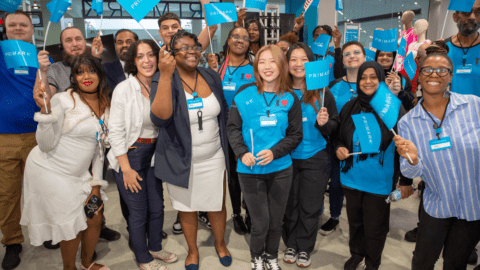Following is Part 1 of the two-part report, titled: Customer Loyalty In 2013 And Beyond. In this article, customer loyalty experts and retail thought leaders discuss the ways retail organizations can update their loyalty programs to deliver on the cross-channel promise. Part 2 of the feature will appear in the July 30 newsletter.
Loyalty initiatives — including discounts, free products, and exclusive access to events and offers — have successfully captured consumer attention for generations, and continue to do so. In 2012, loyalty program memberships totaled close to 2.65 billion in the U.S., a 27% increase over 2010, according to research from COLLOQUY. Additionally, the average U.S. household now participates in 21.9 programs — up from 18.4 in 2010.
A number of retail segments are experiencing significant increases in loyalty program sign-ups: Department stores (+70%); Drug stores (+45%); Specialty stores (+26%); and Mass Merchants (+8%). This is an opportunity for the retailers that can deliver compelling loyalty programs to members.
Advertisement
To compete in today’s tech-savvy marketplace, companies must find unique ways to differentiate and customize their loyalty programs. Companies like Office Depot, Sephora, Gilt Groupe and Starbucks have found success using innovative approaches to loyalty. These retailers are tapping the latest mobile, social and local tools to pique consumer interest.
Retailers are faced with an ongoing challenge to not only guarantee their loyalty programs pique interest but also are used consistently by consumers, according to The 2013 COLLOQUY Loyalty Census report. This challenge is confirmed in the research: While loyalty program memberships across retail categories experienced a surge between 2010 and 2012, only 9.5% of members currently are actively using their accounts and redeeming offers. This somewhat lackluster participation “suggests some staleness in the value propositions of retail programs,” the report stated.
“If you look at typical loyalty programs across retail, travel and hospitality, they have a combination of rewards, recognition and customization,” said Jonathan Copulsky, Principal at Deloitte, in an interview with Retail TouchPoints. However, there are several issues with the way many retailers approach these three tiers, he noted. “What we now know is rewards only work for certain people. In addition, the rewards that may matter to one segment may not matter to another. Retailers need to develop differentiated rewards. Recognition also tends to be a one size fits all, which hinders program adoption.”
Additionally, with e-Commerce, mobile and social media holding more influence on consumers’ browsing and buying behaviors, retailers are considering how to revise their loyalty strategies to address omnichannel shopping strategies.
Amping Up Loyalty Programs To Engage Tech-Savvy Shoppers
By offering consumers valuable and relevant experiences across all channels, retailers can drive sales without focusing solely on discounts and price, according to Shep Hyken, Bestselling Author, and Chief Amazement Officer of Shepard Presentations.
“We have to attack customer loyalty in a completely different way than we ever have before,” Hyken explained. “Ultimately, the goal is to make price less relevant. But currently, when looking at loyalty programs, it is evident that many consumers are loyal to some programs, but not necessarily the retailers.”
Best-in-class retailers are creating more compelling loyalty programs by integrating mobile, social, local and gamification elements into their loyalty programs and initiatives.
For example, Office Depot has implemented a new rewards program to provide consumers with a variety of incentives based on their overall engagement. Members can earn points for purchasing ink, toner, paper and printing services, and even for recycling ink and toner cartridges.
Consumers also can earn points by sharing personal information with Office Depot and “connecting with the brand,” according to a company press release. Points are rewarded based on the amount of information customers provide in their member profiles.
Mobilized Loyalty Programs Allows Instant Connectivity
As consumers become more savvy and connected to technology, they are asking that retailers provide instant access to loyalty programs and coupons.
To keep pace with this demand, The Melt, a fast-casual restaurant chain specializing in grilled cheese sandwiches, has adopted the Perka platform to create a mobile loyalty program called “The Melt Perks.”
Consumers use mobilized punch cards to earn a free melt for every nine they purchase via mobile or the company web site. Loyal customers also are able to earn “Perks+” status when they buy at least one melt in five separate orders within 30 consecutive days.
However, the intersection of mobile and location presents an even better opportunity for retailers to connect with consumers while consumers are in-store, or even in specific aisles.
“The mobile-local connection is very powerful,” said Larry Freed, President and CEO of ForeSee Results. “Using these two methods together presents another way for retailers to engage and market to consumers.”
Apple Passbook, for instance, provides consumers with more seamless access to their loyalty membership cards. When shoppers visit store locations, they open the Passbook app and store associates scan a digital loyalty card barcode, allowing consumers to instantly collect loyalty points, and redeem coupons and offers at the point of sale.
With location-based technology, Passbook also disseminates real-time updates and alerts to users for passes they own. All loyalty cards are stored on the iPhone lock screen so that when shoppers are near a specific location and unlock their smartphones, the loyalty card appears automatically.
One of the first retail partners of Passbook when it launch in September 2012, Sephora saw more than 400 thousand Beauty Insider loyalty program passes created in the first 90 days. Johnna Marcus, Director of Mobile and Digital Store Marketing at Sephora shared insights on the success of this implementation during the Mobile FirstLook conference. As a result of this burst in interest and activity, Sephora plans to focus more on promoting consumers’ abilities to redeem and store gift cards, as well as store loyalty account information on Passbook.
However, seamless mobile redemption processes sometimes is not enough. It also is imperative that content and offers are personalized to specific consumers and their unique relationships with retailers, according to Copulsky.
“A key best practice for loyalty initiatives is customizing and creating a differentiated experience by taking customer data and making programs meaningful,” Copulsky said. “The overall experience with a loyalty program is important — from the rewards to the recognition — but the stakes to be relevant are much higher.”
Harnessing structured and unstructured data across channels will provide retailers with an in-depth look into shopper preferences, which will empower organizations to create more relevant and timely rewards, according to Esprit Smith, who is retail industry expert at Lenati, a customer loyalty consultancy.
“Cookies, geo-fencing, and other tracking technologies allow retailers to gather data including shopper purchase history, spend, and browsing behavior,” Smith said. “As a result, retailers can create incentives that are targeted to an individual customer, which helps acquire new customers — particularly younger generations with a stronger affinity towards ‘me-marketing.’”
Using Social To Engage Advocates And Tastemakers
Most (78%) U.S. Internet users said they show their loyalty to brands by spreading the word on their experiences, according to research from ClickFox, a customer experience analytics company.
As consumers become more willing and eager to share their past retail experiences, retailers should consider how they can make social media a core component of loyalty programs and initiatives, according to Smith.
“Social media is a natural engagement driver, so it is important for retailers to identify how networking channels can fit into their programs,” Smith said. “Retailers should think about all the ways it can enhance their loyalty initiatives and overall customer engagement.”
Retailers can harness social media to track and analyze customer perspectives, as well as identify key brand influencers. Then, organizations can create unique and compelling experiences for these shoppers by having one-to-one conversations with them, and offering unique offers and opportunities. Using this strategy can help brands and retailers drive word-of-mouth among advocates and in turn, boost brand awareness in new segments.
For example, Gilt Groupe has established a loyal following across social networks by providing brand followers and advocates VIP access to sales and offers. The loyalty program for the flash sale eTailer also provides mobile app users and social followers with a variety of rewards and incentives such as entry to exclusive events and sales, Smith explained. Finally, if consumers participate in the online referral program, they have the chance to earn a $25 credit if they share their favorite products on Facebook, Twitter and Pinterest, and friends join the site by clicking on social posts.
“The combination of social marketing and word-of-mouth is most effective for customer acquisition,” Freed said. “Social media needs to be about consumer-to-consumer dialogue. The viral nature of those conversations is why social media can be so powerful.”
Gamification And The Next Generation Of Loyalty Programs
Taking mobile and social to the next level, retailers are looking to gamification as a way to make their loyalty programs more fun and interactive. By implementing game-inspired elements and mechanics into rewards programs — such as badges, rewards thresholds and titles — retailers can boost foot traffic, engagement and sales.
“Just about every retailer can benefit from using game mechanics in their loyalty programs,” said Darren Brady, Account Manager at BigDoor, a gamification solution provider. “Using gamification is a good way to broaden the sales funnel, and get more people to touch the brand on a consistent basis.”
Because customers today have so many options available across channels, they’re ultimately going to go back to the retailers that provide the most value, Brady explained. With a gamified loyalty program, “retailers can instantly connect with consumers and notify them regarding their current rewards, teach them how they can earn more, and encourage them to participate in the program more frequently.”
Starbucks has amped up loyalty initiatives by integrating the mobile payment app with the My Rewards program. Consumers load funds onto the app, and use their mobile devices to complete transactions. Starbucks then rewards users for these purchases with “stars,” status levels and rewards. Calls-to-action and words of encouragement also are included in the app, which provides customers with an extra incentive to keep using their loyalty cards.
“The folks at Starbucks are geniuses because they created the loyalty program thinking about what the customers want, not about the brand itself,” Hyken said. “If you’re trying to secretly create a marketing program and disguise it as a loyalty program, that isn’t going to work in the long term.”
Confirming the importance of creating a fun environment for consumers to engage with a brand, Hyken also pointed out how HSN is leveraging gamification on the e-Commerce site. The HSN Arcade offers a variety of games, such as Crossword and Sudoku, on approximately two-thirds of a computer screen. On the remaining portion of the screen, HSN plays a live stream of the company’s television channel. Players receive tickets for each game, which are redeemable for digital badges that showcase their expertise and status.
With this strategy, HSN “gets people to log on every day just to play games, and sometimes they even buy products,” Hyken explained. “The beautiful thing about that kind of online experience is it doesn’t really cost much. But it also enables the retailer to create a forum for consumers to have fun and experience what the brand is about.”
Innovative retailers such as Gilt Groupe, HSN and Sephora are extending beyond the boundaries of standard loyalty programs to create compelling customer experiences.
As shoppers become more educated and savvy, retailers must revise their initiatives to keep pace with technological trends and evolving shopping behaviors. Only then will they be able to garner long-term engagement and loyalty
Part 2 of the feature, titled: Customer Loyalty In 2013 And Beyond will appear in the July 30 newsletter.








